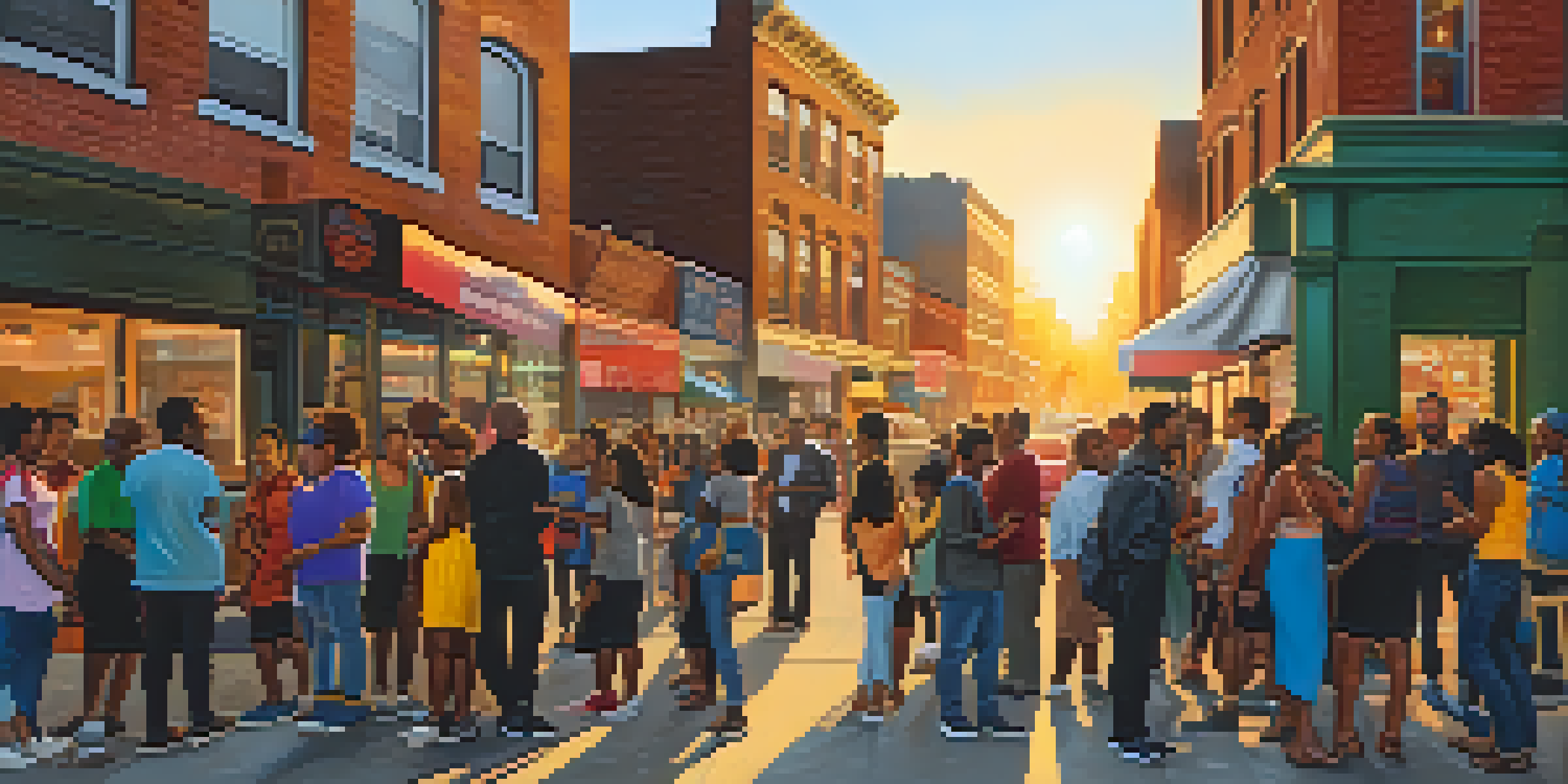Trends in Violent Crime: An Overview of NYC Data

Understanding NYC's Violent Crime Landscape
New York City has long been a focal point for discussions about crime, particularly violent crime. Over the years, the city has witnessed significant fluctuations in crime rates, making it essential to understand the current landscape. This overview examines recent data, offering insights into the types of violent crimes prevalent today and how they compare to historical trends.
Violence is like a virus; it spreads in silence and isolation, and we must break that cycle through community support and engagement.
In recent years, certain types of violent crime, such as shootings and homicides, have garnered significant attention. For example, 2021 saw a spike in shootings compared to previous years, prompting concerns among residents and city officials alike. Understanding these trends helps paint a clearer picture of safety in the city and informs effective policing strategies.
Additionally, examining the demographic and geographic factors influencing crime rates in NYC can provide a more nuanced understanding of the issue. By analyzing specific neighborhoods, we can identify areas experiencing higher rates of violent crime and the underlying factors contributing to these trends.
Recent Trends in Homicide Rates
Homicide rates in NYC have fluctuated over the decades, with noticeable spikes and declines. In 2020 and 2021, the city experienced a significant increase in homicides, raising alarms among residents and law enforcement. Understanding the reasons behind this uptick is crucial for developing effective interventions and prevention strategies.

Factors contributing to rising homicide rates can include economic stress, increased gun violence, and social unrest. For instance, the COVID-19 pandemic has had far-reaching effects on communities, exacerbating existing issues and leading to increased violence in some areas. Analyzing these factors can help stakeholders devise targeted approaches to address the root causes of violence.
Rising Homicide Rates in NYC
Recent years have seen a troubling increase in homicide rates, driven by factors such as economic stress and the impacts of the COVID-19 pandemic.
Looking ahead, it is essential for city officials and community leaders to engage in open dialogues about public safety. By collaborating and sharing insights, they can work together to create comprehensive strategies aimed at reducing homicide rates and fostering safer neighborhoods for all residents.
The Rise of Gun Violence in NYC
Gun violence has emerged as a critical concern in NYC, especially in recent years. The data shows a marked increase in shootings, which has sparked debates about public safety and gun control measures. Understanding the factors behind the rise in gun violence is essential for effective policymaking and community outreach.
The greatest weapon against crime is a community that cares, works together, and supports its members.
Many experts point to the accessibility of firearms and social factors such as poverty and education as contributing elements to this trend. The interplay between these factors can create a volatile environment where gun violence becomes more likely. Community programs focused on education and intervention can play a vital role in mitigating these issues.
As the city continues to address gun violence, there is also a growing emphasis on the importance of mental health support. Providing resources for those in crisis can help prevent violent incidents and promote a safer, healthier community. By fostering an environment that prioritizes mental well-being, the city can make strides toward reducing gun violence.
Analyzing Assault and Domestic Violence Trends
Assault and domestic violence are two categories of violent crime that have also seen notable trends in NYC. The city has implemented various initiatives aimed at reducing these forms of violence, but challenges remain. Recent data indicates fluctuations in reported cases, highlighting the complexity of addressing these issues effectively.
Domestic violence, in particular, has been exacerbated by the pandemic, as many individuals found themselves in isolation with their abusers. This troubling trend underscores the need for increased awareness and resources for victims. Community support programs and law enforcement training are vital in addressing these situations and ensuring safety.
Gun Violence on the Rise
The surge in gun violence in NYC has raised concerns, highlighting the need for effective community programs and mental health support.
Furthermore, understanding the relationship between socioeconomic factors and assault rates can help inform prevention strategies. By targeting at-risk communities with education and resources, the city can work towards reducing the incidence of assault and fostering a culture of non-violence.
The Impact of COVID-19 on Crime Trends
The COVID-19 pandemic has significantly impacted crime trends across the globe, and NYC is no exception. Initial lockdowns and social distancing measures led to a temporary decrease in certain types of crime, but as restrictions eased, violent crime rates surged in some areas. Analyzing how the pandemic has reshaped the crime landscape is essential for understanding current trends.
Many experts believe that the pandemic's economic consequences have contributed to rising crime rates. Job losses and financial instability can lead to desperation, which may increase the likelihood of criminal behavior. Additionally, the stress and anxiety caused by the pandemic can exacerbate interpersonal conflicts, leading to higher rates of domestic violence and assaults.
As NYC continues to recover from the pandemic, it will be crucial for city officials to address these underlying issues. Investing in community support services and creating job opportunities can help reduce the long-term impact of COVID-19 on crime rates, fostering a safer environment for all residents.
Community Initiatives to Combat Violent Crime
In response to rising violent crime rates, NYC has seen a surge in community initiatives aimed at prevention and intervention. These programs often focus on building relationships between law enforcement and residents, fostering trust and collaboration. By working together, communities can create safer environments and address the root causes of violent crime.
One successful approach has been the implementation of youth engagement programs that provide positive outlets for at-risk individuals. By offering mentorship and educational opportunities, these initiatives help steer youth away from criminal activities. Additionally, community organizations play a vital role in providing resources and support to those affected by violence.
Community Initiatives for Safety
NYC is witnessing a rise in community-led initiatives aimed at preventing violent crime through collaboration and support for at-risk individuals.
Moreover, collaboration between various stakeholders, including schools, local businesses, and nonprofits, can yield significant results. By pooling resources and expertise, these partnerships can develop comprehensive strategies that address the complexities of violent crime in NYC. Ultimately, a united effort can pave the way for a safer and more resilient city.
Looking Ahead: Future Crime Trends in NYC
As we analyze the current trends in violent crime, it's essential to consider what the future may hold for NYC. Ongoing research and data collection will be crucial in identifying emerging patterns and potential threats. By staying informed, city officials can develop proactive strategies to maintain public safety.
One area of focus will likely be the continued impact of socioeconomic factors on crime rates. As the city recovers from the pandemic, addressing issues such as housing, education, and employment will be vital in reducing violent crime. Ensuring that all residents have access to resources and opportunities can help create a more equitable society.

Furthermore, technology and data-driven approaches will play an increasingly important role in crime prevention. By utilizing advanced analytics and community feedback, law enforcement can better allocate resources and develop targeted interventions. Ultimately, a proactive and informed approach will be key to addressing violent crime trends in NYC moving forward.